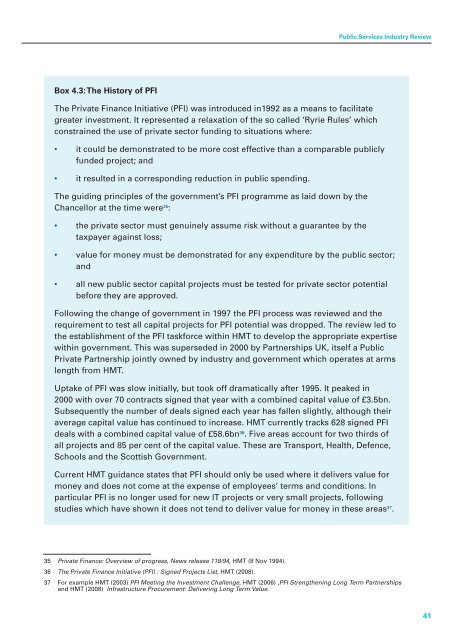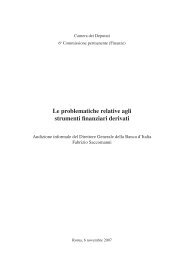Understanding the Public Services Industy
Understanding the Public Services Industy
Understanding the Public Services Industy
Create successful ePaper yourself
Turn your PDF publications into a flip-book with our unique Google optimized e-Paper software.
<strong>Public</strong> <strong>Services</strong> Industry Review<br />
Box 4.3: The History of PFI<br />
The Private Finance Initiative (PFI) was introduced in1992 as a means to facilitate<br />
greater investment. It represented a relaxation of <strong>the</strong> so called ‘Ryrie Rules’ which<br />
constrained <strong>the</strong> use of private sector funding to situations where:<br />
•<br />
•<br />
it could be demonstrated to be more cost effective than a comparable publicly<br />
funded project; and<br />
it resulted in a corresponding reduction in public spending.<br />
The guiding principles of <strong>the</strong> government’s PFI programme as laid down by <strong>the</strong><br />
Chancellor at <strong>the</strong> time were 35 :<br />
•<br />
•<br />
•<br />
<strong>the</strong> private sector must genuinely assume risk without a guarantee by <strong>the</strong><br />
taxpayer against loss;<br />
value for money must be demonstrated for any expenditure by <strong>the</strong> public sector;<br />
and<br />
all new public sector capital projects must be tested for private sector potential<br />
before <strong>the</strong>y are approved.<br />
Following <strong>the</strong> change of government in 1997 <strong>the</strong> PFI process was reviewed and <strong>the</strong><br />
requirement to test all capital projects for PFI potential was dropped. The review led to<br />
<strong>the</strong> establishment of <strong>the</strong> PFI taskforce within HMT to develop <strong>the</strong> appropriate expertise<br />
within government. This was superseded in 2000 by Partnerships UK, itself a <strong>Public</strong><br />
Private Partnership jointly owned by industry and government which operates at arms<br />
length from HMT.<br />
Uptake of PFI was slow initially, but took off dramatically after 1995. It peaked in<br />
2000 with over 70 contracts signed that year with a combined capital value of £3.5bn.<br />
Subsequently <strong>the</strong> number of deals signed each year has fallen slightly, although <strong>the</strong>ir<br />
average capital value has continued to increase. HMT currently tracks 628 signed PFI<br />
deals with a combined capital value of £58.6bn 36 . Five areas account for two thirds of<br />
all projects and 85 per cent of <strong>the</strong> capital value. These are Transport, Health, Defence,<br />
Schools and <strong>the</strong> Scottish Government.<br />
Current HMT guidance states that PFI should only be used where it delivers value for<br />
money and does not come at <strong>the</strong> expense of employees’ terms and conditions. In<br />
particular PFI is no longer used for new IT projects or very small projects, following<br />
studies which have shown it does not tend to deliver value for money in <strong>the</strong>se areas 37 .<br />
35 Private Finance: Overview of progress, News release 118/94, HMT (8 Nov 1994).<br />
36 The Private Finance Initiative (PFI) : Signed Projects List, HMT (2008).<br />
37 For example HMT (2003) PFI Meeting <strong>the</strong> Investment Challenge, HMT (2006) ,PFI Streng<strong>the</strong>ning Long Term Partnerships<br />
and HMT (2008) Infrastructure Procurement: Delivering Long Term Value.<br />
41
















